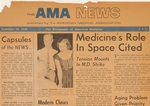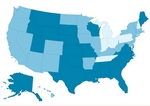business
Health care still driving job creation, but pace may slow
■ New positions are added to hospital and physician office payrolls amid signs of volatility.
By Victoria Stagg Elliott — Posted Oct. 18, 2010
- WITH THIS STORY:
- » Health care: adding jobs
- » Health care jobs month by month
- » Related content
The health care sector continues to create jobs as the economy recovers, but there are indications this may taper off, according to several reports released in September and October.
Private sector payrolls added 64,000 jobs in September and health care represented about one-third of that growth, according to Bureau of Labor Statistics data released Oct. 8. About 23,900 jobs were added to this sector, with 3,400 in physician offices and 2,900 in hospitals.
These numbers were not broken down by occupation, although most experts believe more clinical staff are being hired rather than administrative or support staff.
In the recession and its aftermath, health care has been one of the few sectors consistently adding jobs.
Hospitals added 104,700 positions in 2008 and 25,700 in 2009. Physician offices added 33,400 jobs in 2008 and 44,000 in 2009.
Through September, physician offices had added 19,900 jobs in 2010 and hospitals had added 29,200.
However, there are signs of volatility in health care hiring.
Mass layoffs -- job actions involving 50 employees or more -- at hospitals are on pace to reach 153, one more than 2009's record. Advertising for health care jobs has slowed, and an index measuring demand for labor in this sector has declined.
The monthly report from the Conference Board, issued Sept. 29, about online job ads in September found that the number for health care practitioners and technical jobs had declined for the third consecutive month. About 516,300 job ads were published online in September, 26,200 fewer than in August. This category includes physicians, although the decrease was primarily a result of a reduction in advertised vacancies for registered nurses and physical and occupational therapists.
The Health Workforce Solutions Labor Market Pulse Index, released Oct. 8, also declined 14% to 50.62 in the third quarter of 2010 from 58.60 in the second quarter of this year. The index is an aggregate measure of demand for labor by the health care system, although it varies widely when broken down by location.
For example, in the third quarter, the index skyrocketed 485% in Las Vegas but declined 55% in Orlando, Fla. The number primarily is affected by health care institutions building new facilities or expanding old ones, and those behind the index contend that health care hiring will continue to improve.
"Despite a drop-off in near-term demand for the quarter, we remain convinced that health care hiring has generally improved over the last year, and we expect it to continue through the remainder of the year," said David Cherner, managing partner of Health Workforce Solutions in San Francisco. "There are a number of large expansion projects that will be coming on line over the next few quarters, and much of the negativity reflected in this quarter's numbers come from job cuts previously announced."













